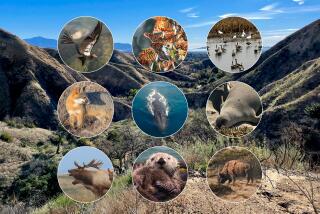TIP-OFF : Eyeing the Tiger
- Share via
MOMMY, WHERE’S THE tiger?”
“I don’t know, dear; he must be sleeping.”
A sad, familiar scene at the zoo, but it is possible to see a lively, wide-awake, walking-around cat; you just have to know the feeding schedule and plan to arrive about a half-hour before the food does. The cats will be up and prowling, impatient for dinner.
At the Los Angeles Zoo, the big cats are fed “off exhibit” around 4 p.m., so arrive at their cages about 3:30. Zoo spokeswoman Deborah Pollack also recommends an early visit--from 10 a.m., when the zoo opens, to 11 a.m. The zoo currently has Bengal tigers, African lions, Eurasian leopards and South American jaguars.
At the San Diego Wild Animal Park, the Sumatran tigers are fed after noon. Visitors can walk or ride the monorail around their three-acre enclosure. From 9 a.m., when the park opens, until noon, the cats are stretching their legs; it’s usually cooler then, so they’re more active. A mother cheetah and her four new cubs are on exhibit along the Kilimanjaro hiking trail; they’re most active in the morning, too. The gates close at 6 p.m., but people can stay on the grounds until 7.
At the San Diego Zoo, the big cats are fed after the humans go home, so the best time to view them is in the morning. The Tiger River rain-forest exhibit, viewed through glass, not only has Sumatran tigers but also features birds, reptiles, even a tapir. Asiatic lions, Indo-Chinese and snow leopards and jaguars are on exhibit elsewhere--and are also most active in the morning. The zoo opens at 9 a.m., gates close at 5 p.m.; members of the Zoological Society of San Diego are occasionally allowed in earlier, about 8 a.m.
More to Read
Sign up for The Wild
We’ll help you find the best places to hike, bike and run, as well as the perfect silent spots for meditation and yoga.
You may occasionally receive promotional content from the Los Angeles Times.






